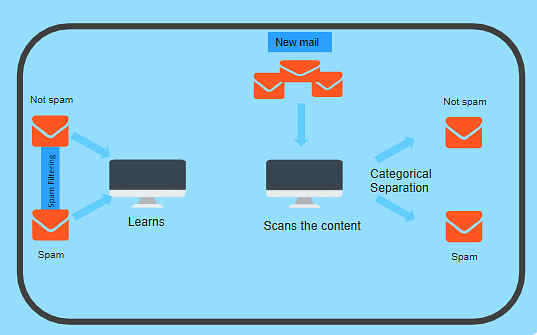What is Machine Learning?
Machine learning (ML) is a subdomain of artificial intelligence (AI) that focuses on developing systems that learn—or improve performance—based on the data they ingest.
Arthur Samuel first used the term "machine learning" in 1959.
Machine Learning is the field of study that gives computers the capability to learn without being explicitly programmed.
Machine learning algorithms create a mathematical model that, without being explicitly programmed, aids in making predictions or decisions with the assistance of sample historical data, or training data. To develop predictive models, machine learning brings together statistics and computer science.
Features of Machine Learning
Automation: Machine learning automates the process of learning patterns and making predictions from data, reducing the need for explicit programming.
Prediction: It can predict future outcomes or classify data into categories based on historical patterns.
Adaptability: Machine learning models can adapt and improve their performance over time as they receive more data.
Pattern Recognition: It excels at identifying patterns in data that may not be apparent to humans.
Generalization: ML models can apply what they've learned to new, unseen data, making them useful for a wide range of tasks.
Data-Driven: ML relies on data as its primary source of information, learning from examples and experiences.
Scalability: It can handle large datasets and complex problems, scaling up to big data applications.
Personalization: Machine learning can be used to create personalized recommendations and user experiences.
Speed and Efficiency: ML algorithms can process and analyze data much faster than traditional methods.
Continuous Learning: The ability to continually learn and adapt to new data without constant human intervention.
Automation of Decision Making: ML can make decisions or provide recommendations based on data, reducing the need for manual decision-making.
Anomaly Detection: It can identify unusual or unexpected patterns in data, which is valuable for fraud detection and fault diagnosis.
Natural Language Processing (NLP): ML can understand and generate human language, enabling chatbots and language translation.
Computer Vision: It can analyze and understand visual data, enabling tasks like facial recognition and object detection.
Clustering: ML can group data into clusters, helping in customer segmentation and data organization.
Regression Analysis: It can be used to predict numeric values, such as sales forecasts or price predictions.
Classification: ML can classify data into categories, such as spam or not spam emails.
Optimization: ML can find the best solutions to complex problems, such as route optimization for delivery services.
Continuous Improvement: ML models can improve over time as they receive more data and feedback.
Cost Reduction: By automating tasks and making better decisions, machine learning can help reduce operational costs.
A Visual Introduction to Machine Learning

http://www.r2d3.us/visual-intro-to-machine-learning-part-1/

Types of Machine Learning
Supervised learning: The model or algorithm is presented with example inputs and their desired outputs and then finds patterns and connections between the input and the output. The goal is to learn a general rule that maps inputs to outputs. The training process continues until the model achieves the desired level of accuracy on the training data. Some real-life examples are:
Image Classification: You train with images/labels. Then in the future, you give a new image expecting that the computer will recognize the new object.
Market Prediction/Regression: You train the computer with historical market data and ask the computer to predict the new price in the future.
Risk Assessment: Supervised learning is used to assess the risk in financial services or insurance domains to minimize the risk portfolio of the companies.
Fraud Detection: To identify whether the transactions made by the user are authentic or not.
Visual Recognition: The ability of a machine learning model to identify objects, places, people, actions, and images.

Classification:

Regression:

Unsupervised learning: No labels are given to the learning algorithm, leaving it on its own to find structure in its input. It is used for clustering populations in different groups. Unsupervised learning can be a goal in itself (discovering hidden patterns in data).
Clustering: You ask the computer to separate similar data into clusters, this is essential in research and science.
High-Dimension Visualization: Use the computer to help us visualize high-dimension data.
Generative Models: After a model captures the probability distribution of your input data, it will be able to generate more data. This can be very useful to make your classifier more robust.

Clustering Unsupervised Learning:

Association Unsupervised Learning:

Real-Life Applications of Unsupervised Learning
Market Basket Analysis
It is a machine learning model based on the algorithm that if you buy a certain group of items, you are less or more likely to buy another group of items.
Semantic Clustering
Semantically similar words share a similar context. People post their queries on websites in their own ways. Semantic clustering groups all these responses with the same meaning in a cluster to ensure that the customer finds the information they want quickly and easily. It plays an important role in information retrieval, good browsing experience, and comprehension.
Delivery Store Optimization
Machine learning models are used to predict the demand and keep up with supply. They are also used to open stores where the demand is higher and optimise roots for more efficient deliveries according to past data and behaviour.
Identifying Accident Prone Areas
Unsupervised machine learning models can be used to identify accident-prone areas and introduce safety measures based on the intensity of those accidents.
Semi-Supervised Learning:
Problems where you have a large amount of input data and only some of the data is labeled, are called semi-supervised learning problems. These problems sit in between both supervised and unsupervised learning. For example, a photo archive where only some of the images are labeled, (e.g. dog, cat, person) and the majority are unlabeled.
Reinforcement Learning:
A computer program interacts with a dynamic environment in which it must perform a certain goal (such as driving a vehicle or playing a game against an opponent). The program provides feedback in terms of rewards and punishments as it navigates its problem space.


